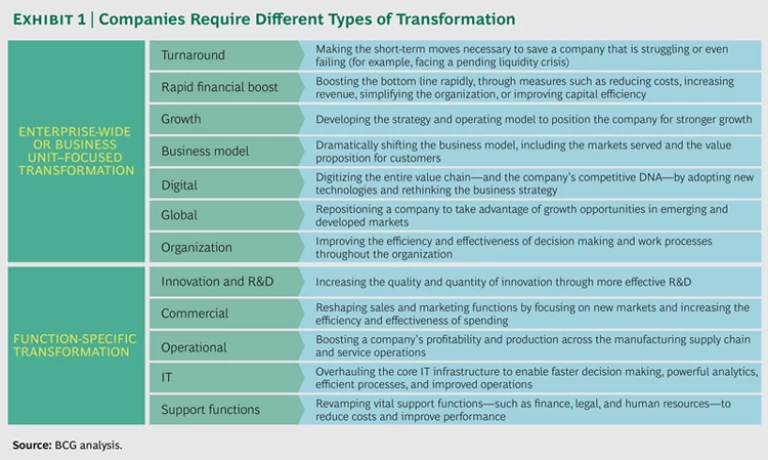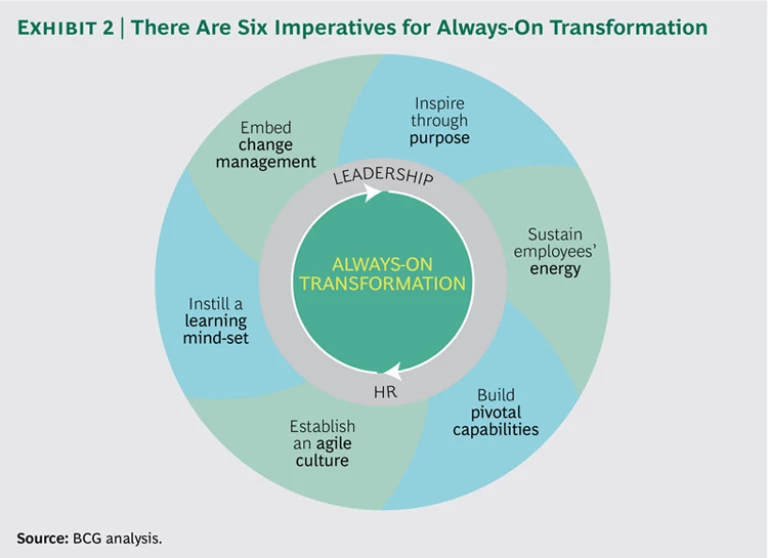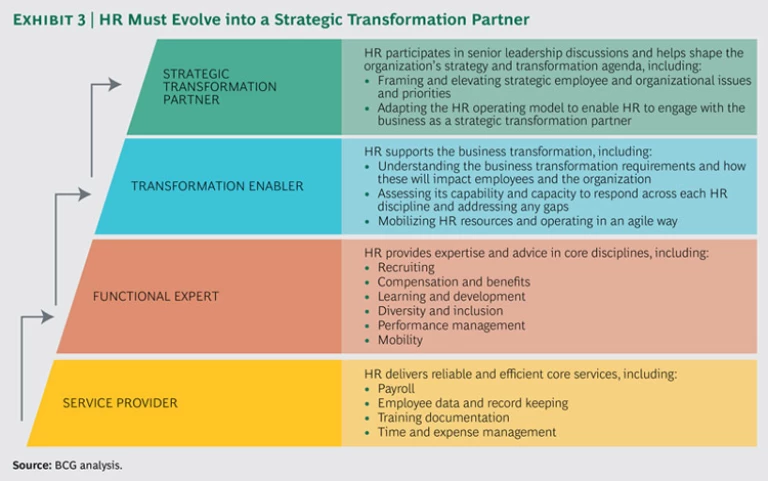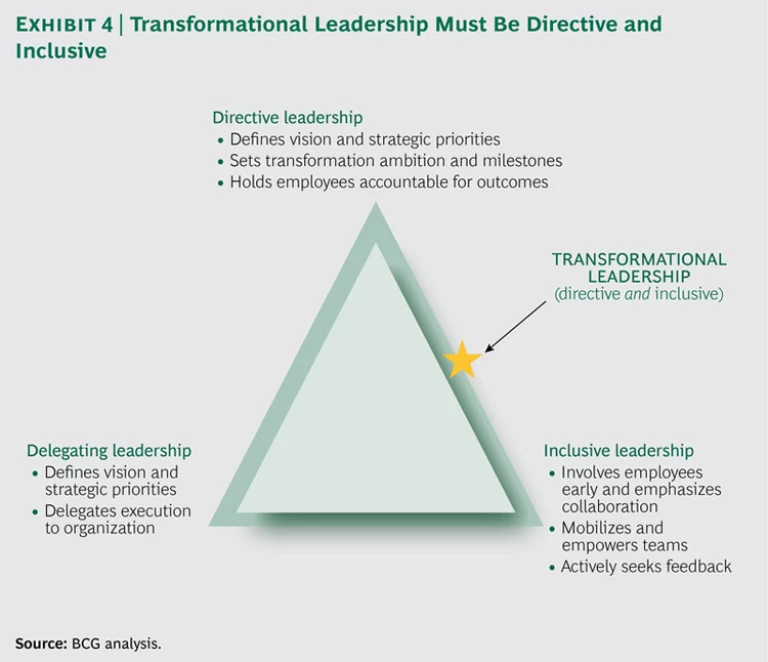For leaders in large corporations, business today often feels like being on a steep treadmill with the speed control set to max. Three months ago, the company may have finished a cost-reduction transformation to remove management layers and streamline operations. Before it is even clear that the changes have taken root, a disruption in Asia requires implementing a new go-to-market model for several countries. And right around the corner is another large-scale transformation effort, using new digital technology to improve the delivery of services and tap new revenue streams.
Welcome to the era of “always-on” transformation. Across virtually all industries, unprecedented disruption and market turbulence—due to globalization, technological innovation, changing regulations, and other factors—are challenging established business models and practices, and requiring organizations to launch more frequent transformations in response. To keep up, companies need to undertake many different types of transformation. (See Exhibit 1.) Any one of these, or several, can be under way at a company at any given time. BCG’s research shows that 85 percent of companies that have undertaken transformations over the past decade have pursued more than one type, with the most common being organizational, operational, and rapid financial improvements.
We define a transformation as a profound change in a company’s strategy, business model, organization, culture, people, or processes—either enterprise-wide or within a specific business unit, function, or market. A transformation is not an incremental shift in some aspect of the business but a fundamental change aimed at achieving a sustainable, quantum improvement in performance and, ultimately, shareholder value. (For an explanation of BCG’s transformation framework, see Transformation: The Imperative to Change, BCG report, November 2014.) Unlike continuous improvement—which focuses on small-scale changes that start with employees and percolate up through the organization—always-on transformation requires a series of much larger, interdependent initiatives that are driven by top management.
In this new era, the ability to implement transformation has become a competitive differentiator. Yet most companies are not reaping rewards from transformation efforts. According to BCG’s analysis, only 24 percent of companies that complete transformations outperform competitors in their industries in both the short and long term.
Whether the objective is rapid bottom-line improvements or more fundamental changes to business and operating models, company leaders need a more effective approach. Rather than focusing on short-term targets alone (for example, a 20 percent improvement in operating efficiency), companies need to go much deeper in order to sustainably improve performance through individual transformations and to ingrain the ability to transform so as to meet future needs.
In this report, we discuss the main reasons that the current approach to transformation falls short, and we describe specific changes that organizations can make to achieve better results. Specifically, we discuss six organizational imperatives that companies need to focus on—along with new roles for HR and leadership—in order to thrive in the era of always-on transformation.
Root Causes of Failure
Why do most companies fail to meet their transformation goals? There are several reasons. The first is that companies typically adopt a short-term, top-down approach to implementation. Transformations are energy intensive and are often executed under tremendous pressure from boards and other stakeholders—frequently as a reaction to flagging performance—which leads management teams to seek fast fixes and immediate results. Consequently, many companies simply seek to compel employees to change their behaviors. They motivate through carrots and sticks—mostly sticks—rather than tapping into the intrinsic motivators that can spur employees to improve performance in a sustainable manner.
Second, successful transformations increasingly require changes to business and operating models, which in turn require new ways of thinking and working. Yet more often than not, companies fail to build the capabilities required to enable people to work in new and different ways. Without adequate attention to enabling new behaviors and ways of working, companies do not achieve and sustain the results they desire.
A third reason underlying the failure to reach transformation goals is that many companies approach transformation in a one-off manner—treating each initiative as an independent event. Under this flawed thinking, they essentially put up scaffolding around one aspect of the organization, focus intently on changing some part of it, and then take down the scaffolding, thinking that they can revert to steady-state operations.
This kind of short-term, one-off approach is akin to the way some schools prepare students for standardized tests. In an attempt to improve test scores, teachers try to cram knowledge into students’ heads—basically “teaching to the test” for a few frenzied weeks leading up to the tests. That approach can work—scores often do go up to meet the short-term objective of doing well on the tests—but it doesn’t meet the fundamental goals of education: making sure students learn the underlying skills that will help them succeed over the long term.
Six Key Imperatives
Companies that are not just surviving but thriving in the era of always-on transformation focus on six specific imperatives. (See Exhibit 2.) We identified these six by reflecting on the many transformations that BCG has been involved with over the past decade—particularly multiple transformations within the same company. All six have one unifying trait: they are aimed at putting people first.
Management teams that focus on these six imperatives can create a new type of organization in which transformation is not a temporary, bolt-on approach to delivering one-off, short-term results but rather an ongoing and integral means of delivering superior performance. Although we have observed some companies that have successfully integrated some of these elements, very few have ingrained all six. Those companies that do so are positioning themselves to thrive in the era of always-on transformation.
Inspire through purpose. Most transformations focus on financial or operational goals (for example, increasing revenue or improving operating efficiency). While such goals are extremely important—and motivating to the board, investors, and senior management—they tend to be an underwhelming motivator for the majority of employees.
In order to get employees to buy into a transformation, its goals must be tied to the deeper and more inspiring purpose of the company (which transcends any given transformation). BrightHouse, an independent division of BCG that helps companies embrace a more purpose-driven culture, has found that when organizations can clearly define and communicate their purpose to employees—that is, the “why”—these employees feel that they are part of something bigger. And when employees believe in the company’s purpose, they are intrinsically motivated to go above and beyond. (See the sidebar “A Retailer Uses Purpose to Inspire Employees and Improve Business Results.”)
A RETAILER USES PURPOSE TO INSPIRE EMPLOYEES AND IMPROVE BUSINESS RESULTS
A North American retailer had a successful history of increasing sales through aggressive pricing and maintaining margins by keeping costs low. However, it faced increasing pressure from competitors, and it was struggling to motivate retail sales associates and engage with customers in a meaningful way. In response, it launched a transformation with a strong emphasis on purpose.
The company’s leaders conducted deep qualitative and quantitative research to determine the most salient ways to connect with customers and in-store associates on a more emotional level. They also explored the company’s corporate history and organizational strengths in order to understand its values and heritage. As a result of this process, the management team defined a new purpose and launched a comprehensive transformation of its stores—with that purpose as its foundation—aimed at improving everything from customer interactions to merchandising. It tested the new approach in 20 pilot stores and then in a full division. Based on compelling test results, the company has begun rolling out the new approach to the rest of its locations.
With this purpose as a guiding principle, the transformation has been highly successful. Customer-experience and associate-engagement scores have improved significantly, as have key financial metrics such as same-store sales and market share.
Once a company has formulated and articulated its clear overarching purpose, all subsequent transformations should link directly to it. Moreover, all employees should be able to see how their contributions help the company succeed in those transformations—and better fulfill the company’s broader purpose. All three elements are crucial: a well-defined and shared purpose for the company, a specific link to the transformation at hand, and a clear connection between employees’ actions and contributions to the company’s objectives.
Some practical actions that companies can take to embed a clear purpose in their transformation efforts include the following:
- Ensuring that the company has a clearly defined and articulated purpose that captures the “why” underlying how it functions
- Translating the transformation’s purpose into language and objectives that hold meaning for individual employees (beyond making money for shareholders)
- Communicating the company’s objectives consistently throughout the transformation effort—starting with senior management down through peer-level employees
- Using creative methods—such as inspiring videos and staff events—to engage employees so that they clearly understand the purpose of the transformation and how they can contribute to it
Sustain employees’ energy. In an environment of always-on transformation, companies need to treat transformation as if it were a triathlon, not a sprint. Transformations are typically intense efforts that require employees to go beyond their normal baseline workload. An all-out sprint may work for the first few months, but eventually fatigue will set in and employees will be less able to contribute—particularly when another transformation is likely right around the corner.
A better way is to think like triathletes, who have to swim, bike, and run. Triathletes learn to pace themselves so that they can excel in all three disciplines. Rather than asking employees to maintain a high level of engagement nonstop, companies need to intersperse commitments to high-demand transformation projects with time for true recovery. With the right pacing, employees will be able to engage enthusiastically on each new assignment asked of them, without losing energy. (Notably, there is one group that simply cannot take a break: the senior leadership team.)
Among the practical actions companies can take to sustain the energy of their workforce are the following:
- Recruiting employees who thrive in a transformation environment
- Addressing resistance openly and overcoming resistance through candid conversations
- Structuring initiatives and employees’ roles so as to contribute to personal growth and development
- Allowing employees to recover from energy-intensive transformation efforts before assigning them to the next one
Build pivotal capabilities. Companies are increasingly embarking on transformations that rewire the way they operate—including new business models, digitization, and fundamental changes to the roles of business units and functions. As a result, companies invariably need to build new capabilities, such as processes, knowledge, skills, tools, and behaviors. Knowing how to identify and develop these capabilities in any given transformation is pivotal to success. (See the sidebar “A Software Company Builds New Capabilities as Part of a Transformation.”)
A SOFTWARE COMPANY BUILDS NEW CAPABILITIES AS PART OF A TRANSFORMATION
A leading software and services company recently launched a transformation to change its business model from on-premises licensed software to cloud-hosted software as a service (SaaS). Transforming the company to support the new business model necessitated changes to the organization’s design, culture, and leadership. The transformation also required building new capabilities that are essential to succeeding with SaaS.
For example, under the old model, the company responded to customer problems in a highly reactive manner because it had no way of knowing that customers were experiencing issues until they reported them. However, as part of the SaaS approach, the company rolled out real-time usage dashboards that allowed it to be proactive in anticipating problems. The dashboards helped the company to spot usage patterns, predict customer needs, and address them rapidly—which it bundles into a new capability known as “customer success.” The company has also committed to creating new processes and developing new skills required to deliver against these metrics.
Integrating this new capability has also required rethinking the organization design—considering where best to place the new capability—along with changes to the company’s culture in order to improve its performance over time. For example, by giving the customer success capability a higher profile within the organization, the company was able to attract higher-skilled employees and give them greater say in how the SaaS model functions for specific clients.
For example, a company seeking to become better at innovation may need additional capabilities in primary research, product development, assessing the market potential of new ideas, building a business case, and getting new products to market quickly. To build these capabilities, the company will need to improve its understanding of changes in customer behavior. It may need to develop skills in rapid prototyping and design-to-value methodologies. At the employee level, required changes could well include revamping recruiting strategies and approaches to training, coaching, and development, along with redefining roles and upgrading performance management.
Companies can take the following practical actions to build pivotal capabilities:
- Assessing which capabilities are critical to the success of the transformation by talking to experts and analyzing competitors
- Understanding the root causes of capability gaps—including behavioral and technical issues
- Developing plans to close capability gaps and committing the necessary resources—usually requiring a combination of changes to processes, upgraded skills, new tools, and actions to reinforce new ways of working
- Deciding when to build these capabilities organically and when to accelerate the process through acquisitions, partnerships, or outsourcing
Establish an agile culture. In a business landscape characterized by constant and broad-ranging disruption, the ability to rapidly change course in response to market shifts and to enable employees to adapt the way they work becomes critical. Truly agile organizations don’t just accommodate change and mandate speed—they ingrain these elements into the company’s culture and ways of working. (See the sidebar “A Manufacturer Creates a Playbook for Responding to Market Corrections.”)
A MANUFACTURER CREATES A PLAYBOOK FOR RESPONDING TO MARKET CORRECTIONS
Facing a downturn in demand during the 2008 recession, a large North American manufacturer undertook a major transformation in order to reduce costs. The company’s situation was dire; sales volume had fallen by more than 50 percent, even as prices dropped sharply. The initial transformation was successful—delivering $2 billion in value over three years with a significant jump in market share—yet management realized that was only the first step. The company would need to be agile enough to respond to similar market disruptions in the future.
To meet this need, the manufacturer created a cost-cutting playbook with three tiers for different situations (normal economy, slight downturn, and severe downturn). In a normal economy, the playbook specifies the baseline level of fixed costs. In the event of a slight downturn or a severe downturn, the playbook specifies which costs should be cut first. For example, in a severe downturn in which demand falls dramatically, it makes little sense to spend on selling or marketing at trade shows, so those costs get cut.
With the playbook, business leaders know where their line of business stands in the company’s order of priorities, so they are less likely to try “protecting their turf” by obstructing crucial cost reductions. This awareness increases the company’s responsiveness and agility by removing long deliberations and politics from the cost-cutting process. In addition, the playbook is flexible in that the company can adjust its priorities for the different tiers should there be long-term shifts in the market.
Agile companies are not burdened by excessive layers of management or bureaucracy. Employees have a wide degree of autonomy and are trusted to resolve many of the issues they face without direct oversight. They are able to take on new roles and responsibilities and to swiftly adapt to new ways of working. They are quick to acquire knowledge of new topics, with the understanding that another change is almost certainly coming soon. In addition, agile companies encourage experimentation, and they don’t fear uncertainty. Managers at these companies celebrate and reward risk taking, and they don’t punish failure (only the failure to experiment).
Companies can build agility by making some of the following changes, which we have observed in practice helping companies implement transformations:
- Stripping out bureaucracy—removing organizational layers, simplifying rules and policies, and identifying and eliminating noncritical work
- Hiring people and empowering employees who are excited by dynamic workplaces and taking steps to foster this attitude in other employees
- Publicly celebrating employees who successfully adapt to new roles and behaviors
- Developing mobility programs to help employees gain experience in different roles and learn new ways of thinking, so that they understand how various departments function and what they require to succeed
Instill a learning mind-set. Companies that wish to lay the groundwork for future transformations need to foster a learning mind-set across the entire organization. Such an organizational mind-set entails spurring people to seek out new knowledge, experiment with it, share it, and ultimately use it to improve the company’s performance. For that reason, employees at organizations with a learning mind-set are encouraged to follow their curiosity and challenge conventional thinking. They develop creative ways to improve processes and find better ways to do things. This kind of learning culture requires a free exchange of ideas, an acknowledgment that many new ideas will fail, and an understanding that such failures are an inevitable part of progress. (See the sidebar “A Technology Company Focuses on Learning Across the Entire Organization.”)
A TECHNOLOGY COMPANY FOCUSES ON LEARNING ACROSS THE ENTIRE ORGANIZATION
A large technology company has firmly embedded “learning” throughout its entire organization. State-of-the-art knowledge-management software helps the company share ideas and give real-time feedback on projects. The company also invests heavily in individual learning, through an internal library of courses and tuition reimbursement for college-level programs. The organization’s strong HR-analytics function helps managers make smarter hires and better align talent with the company’s strategic goals. For example, the company captures interview data during the hiring process and uses profiles of employees to determine which characteristics lead to success. The company also studied the factors behind female attrition and revamped its benefits package for new mothers. And when it realized that the top-performing employees delivered significantly greater value than employees who perform in the middle range, the company revamped its compensation structure to provide larger rewards for top performers.
Transformations can be ideal environments in which to promote learning because they demand creative problem solving and new ideas. To encourage the behaviors associated with learning, companies can take the following actions:
- Establishing a central knowledge-management function that codifies learning and creates networks of experts on specific topics
- Encouraging employees to approach problems in unconventional ways
- Getting business units and functions to collaborate and share knowledge across organizational borders
- Celebrating creative and innovative teams
- Setting up regular meetings in which employees from multiple teams, business units, and functions share ideas and experiences
Embed change management. As mentioned earlier, one of the key challenges in transformation is that companies tend to see each initiative as a temporary, one-off event. As a result, companies consider change management as part of the temporary scaffolding of a given transformation effort. Instead, companies need to build change-management skills, make tools available across the broader organization, and consider change management to be a core competency among the extended leadership team. (See Changing Change Management: A Blueprint That Takes Hold, BCG report, December 2012.)
Rather than rolling out each new transformation initiative from scratch—and moving temporary scaffolding around the organization for each one—companies should consider setting up an internal transformation office so as to embed change management in the organization. Companies with a permanent transformation office have dedicated resources to, and institutional expertise in, all aspects of change management, which they can deploy as needed. Properly structured, a transformation office can provide oversight over all transformation efforts, help prioritize and sequence transformations, design individual transformation initiatives, and track progress. The transformation office can also serve as a repository of change-management capabilities in the company. (Some companies have also found it helpful to include related activities—such as lean initiatives and continuous improvement—under the overall mandate of the transformation office in order to ensure the coordination and alignment of all performance-improvement programs.)
Some practical actions companies can take to ingrain change management include the following:
- Making transformation-focused positions attractive to employees—for example, by creating a competitive application process and emphasizing the opportunity to develop relationships with top management
- Establishing strong change-management processes that help transformation leaders plan and roll out change initiatives—including building a case for change, securing stakeholder engagement, designing roadmaps, and implementing rigor testing
- Learning by doing—making the development of internal change-management capabilities an important part of each change initiative
HR As a Strategic Transformation Partner
All of the above imperatives have enormous implications for a company’s people practices and HR policies. As such, HR must play a larger role in this always-on transformation era. Ultimately, HR needs to participate actively in senior leadership discussions, help develop the company’s strategy and transformation agenda, and support the alignment of specific functions with the company’s priorities. To embrace this role, HR needs to evolve beyond its traditional supporting function to become a true strategic transformation partner. (See Exhibit 3.) And, equally important, the company’s senior leadership needs to support HR’s expanded role.
Specifically, HR must understand the requirements of the transformation and how they impact the company’s employee-related processes and HR disciplines. It must work with company leaders to understand how employees and the organization will enable the company’s strategy. It must anticipate the implications of every change initiative on employees and the organization. It must know whether the company has the capability and the capacity to meet its strategic goals. All the while, HR must keep pace with the organization and operate with agility as transformations unfold.
As Exhibit 3 shows, HR’s expanded role requires a new set of capabilities. For example, frequent product and strategy shifts will call for regular upgrades to the organization structure. HR should work with line-of-business leaders to decide how the organization needs to adapt and then orchestrate the process—with the expectation that the organization design will soon need to be upgraded again. Similarly, in a more volatile environment, strategic workforce planning becomes more important—and more difficult. HR must take the lead in assessing and anticipating emerging skills gaps and in developing strategies to meet future needs for talent. (See “Transforming Technology Companies: Putting People First,” BCG article, November 2014.)
Implications for Leadership
There are many things that company leaders must do in any transformation, including defining the ambition; energizing the organization; and preparing, launching, and driving the transformation. (For more on how incoming leaders at organizations should handle transformation, see The New CEO’s Guide to Transformation: Turning Ambition into Sustainable Results, BCG Focus, May 2015.) In the era of always-on transformation, there are two additional critical success factors for leaders: applying a leadership approach that is both directive and inclusive, and charting the optimal path for ingraining the six imperatives described above.
Apply directive and inclusive leadership. As noted earlier, one of the inherent challenges of transformations is that they often take place under intense pressure to achieve rapid results. Under these conditions, leaders cannot afford to be hands-off after they set a broad vision; they cannot delegate the execution and stand back to wait for results. To deliver a fundamental change in performance at an accelerated pace, leaders not only need to define and articulate the vision but also must clearly articulate strategic priorities, set the transformation ambition and milestones, and hold employees accountable for results through regular checkpoints. Still, while strong directive leadership is necessary, in the era of always-on transformation it is not sufficient—because it fails to provide the motivation required for sustained performance and the new ways of thinking needed to develop fundamentally better ways of working. Instead, leaders need to develop a more balanced, “transformational leadership” approach that is both directive and inclusive. (See Exhibit 4.)
Inclusive leaders involve employees early in the process—well before implementation—and make clear how their contributions help fulfill the larger purpose and objectives of the transformation. By taking these steps, the company’s leadership is able to secure a more authentic commitment from employees. Inclusive leaders also mobilize and empower teams by giving them some freedom, within a prescribed framework, to define and implement specific initiatives in the transformation. And they solicit honest feedback and take it into account in modifying the transformation in light of issues that have come up during implementation.
Transformational leadership that is both directive and inclusive clearly raises the bar for executives. It requires an investment in time, energy, and management focus when demands on leaders are, typically, already very high. The bandwidth required to lead in this way is often one of the biggest constraints in a transformation. However, in our experience, making the needed investment of time, energy, and management focus pays off through more efficient and effective execution and more sustainable results. Over time, as the transformation takes hold, leaders can shift to a more delegating style. (For an example of how leaders can steer a company through multiple transformations, see the sidebar “A Global Consumer Company Prepares for the Era of Always-On Transformation.”)
A GLOBAL CONSUMER COMPANY PREPARES FOR THE ERA OF ALWAYS-ON TRANSFORMATION
For more than a decade, a leading global consumer company has delivered double-digit revenue growth and strong profitability. To achieve this performance, the company has successfully implemented multiple transformations aimed at improving its innovation capabilities, developing world-class manufacturing operations, expanding into emerging markets, and reshaping its leadership model.
To support these initiatives, the company has adopted, and directly benefited from, several of the six imperatives discussed in this report. It has an explicit purpose—and the leadership team has taken steps to ensure that transformation programs are tightly linked to that purpose and that employees understand how their actions contribute to achieving that purpose. It also has a learning mind-set and strong cross-functional collaboration, which are wired into the organization’s processes and culture (and monitored through key performance indicators).
In addition, the company is taking steps to improve in several other important areas. Specifically, the leadership team has realized that setting the right pace and sequence of activities is critical to sustaining employees’ energy across multiple transformations, and it has prioritized among the programs currently under way. It also recently assessed its capability gaps and launched a program to build the pivotal capabilities required to continue to grow while adapting to market dynamics. Recognizing the importance of change management, it has set up a transformation office led by a senior executive who holds responsibility for overseeing and integrating the various transformation initiatives and for building organization capabilities.
In addition, the company is elevating, and reshaping, the role of HR into a strategic transformation partner—including appointing a senior executive to lead the function and redesigning the HR operating model to better support the company’s transformation agenda. For its part, the leadership team has truly embraced its new transformational style and role—setting clear direction while being highly inclusive (rather than simply telling employees to “get with the program.”)
Through all of these actions, the company is taking deliberate steps to compete in a highly dynamic market, in which success comes not from any single transformation but from the ability to launch and implement multiple transformations over time.
Ingrain the six imperatives. In addition to applying the right style of leadership, leaders also have to chart the best path for ingraining the six imperatives into the company’s organization and culture. While all six are important, management teams and organizations may not have the capacity to incorporate them all at once. Some will be more critical to a company’s unique situation and to the types of transformation it is undergoing. For example, a company that already has a well-defined and articulated purpose need not spend time developing and communicating it but can move quickly to ensuring that the organization understands how the transformation links to it. Similarly, the pivotal capabilities required by a company that is launching a major operational improvement effort will be different from the capabilities needed by a company that is rolling out a digital initiative. A deliberate approach to prioritization and pace—as well as a thoughtful assessment of internal leadership and organizational bandwidth—will help leaders reach the best outcome.
The days of short-term, one-off transformations are ending. In this extremely dynamic business environment, we have reached the era of always-on transformation. The old approach—that is, top-down orders to employees, with enough oversight to hit short-term targets and declare victory—is no longer a viable option. Instead, companies need to launch near-continuous transformations across business units and functions.
Companies that integrate the six imperatives and adopt the HR and leadership roles outlined in this report should be well positioned to gain sustainable improvements in performance from individual transformations and to ingrain the ability to transform repeatedly over time. Doing so is a significant challenge, but companies have little choice. They can cling to the old ways and become less relevant, or they can embrace a new approach that will enable them not just to survive but to thrive in the era of always-on transformation.
Acknowledgments
The authors thank Allison Bailey, Michael Deimler, Lars Fæste, Anders Fahlander, Grant Freeland, Maya Gavrilova, Jean-Manuel Izaret, June Limberis, Evan Peters, Mai-Britt Poulsen, Martin Reeves, Joey Reiman, David Rhodes, Michael Shanahan, Jon Swan, and Amanda Wikman for their contributions to this report.









